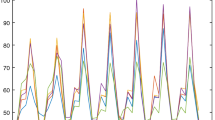Abstract
This work designs a methodology to quantify the uncertainty of a volatility parameter in a stochastic control problem arising in energy management. The difficulty lies in the non-linearity of the underlying scalar Hamilton-Jacobi-Bellman equation. We proceed by decomposing the unknown solution on a Hermite polynomial basis (of the unknown volatility), whose different coefficients are solutions to a system of second order parabolic non-linear PDEs. Numerical tests show that computing the first basis elements may be enough to get an accurate approximation with respect to the uncertain volatility parameter. We provide an example of the methodology in the context of a swing contract (energy contract with flexibility in purchasing energy power), this allows us to introduce the concept of Uncertainty Value Adjustment (UVA), whose aim is to value the risk of misspecification of the volatility model.
Similar content being viewed by others
References
Basel Committee on Banking Supervision (2015) Review of the credit valuation adjustment risk framework. Bank for International Settlements
Bardou O, Bouthemy S, Pages G (2009) Optimal quantization for the pricing of swing options. Appl Math Finance 16(2):183–217
Barrera-Esteve C, Bergeret F, Dossal C, Gobet E, Meziou A, Munos R, Reboul-Salze D (2006) Numerical methods for the pricing of swing options: a stochastic control approach. Methodol Comput Appl Probab 8(4):517–540
Benkert K, Fischer R (2007) An efficient implementation of the Thomas algorithm for block pentadiagonal systems on vector computers. In: Shi Y, van Albada GD, Dongarra J, Sloot PMA (eds) Proceedings of the 7th International Conference on Computer Science, ICCS, pp 144–151
Briand P, Labart C (2014) Simulation of BSDEs by Wiener Chaos Expansion. Ann Appl Probab 24(3):1129–1171
Brennan MJ (1991) The price of convenience and the valuation of commodity contingent claims. Stochastic Models and Option Values 200(22–71)
Barles G, Souganidis PE (1991) Convergence of approximation schemes for fully nonlinear second order equations. Asymptot Anal 4:271–283
Clewlow L, Strickland C, Kaminski V (2001) Valuation of swing contracts in trees. Energy Power Risk Manag 6(4):33–34
Gobet E (2002) LAN Property for ergodic diffusion with discrete observations. Ann Inst H Poincaré, Probab Statist 38(5):711–737
Gerritsma M, van der Steen JB, Vos P, Karniadakis GE (2010) Time-dependent generalized polynomial chaos. J Comput Phys 229(22):8333–8363
Harvey AC (1989) Forecasting, Structural Time Series Analysis, and the Kalman Filter. Cambridge
Huschto T, Sager S (2014) Solving stochastic optimal control problems by a Wiener chaos approach. Vietnam J Math 42(1):83–113
Jaillet P, Ronn EI, Tompaidis S (2004) Valuation of commodity-based swing options. Manag Sci 50:909–921
Keppo J (2004) Pricing of electricity swing options. J Derivatives 11(3):26–43
Kleiber M, Hien TD (1992) The stochastic finite element method (basic perturbation technique and computer implementation). Wiley, Chichester
Le Maître O, Knio OM (2010) Spectral methods for uncertainty quantification: with applications to computational fluid dynamics. Springer Science & Business Media, New York
Loh WL (1996) On latin hypercube sampling. Ann Stat 24(5):2058–2080
Liu W, Yang Y, Lu G (2003) Viscosity solutions of fully nonlinear parabolic systems. J Math Anal Appl 281(1):362–381
Mikulevicius R, Rozovskii B (1998) Linear parabolic stochastic PDE and Wiener chaos. SIAM J Math Anal 29(2):452–480
Mikulevicius R, Rozovskii B (2005) Global L2-solutions of stochastic navier-Stokes equations. Ann Probab 33(1):137–176
Manoliu M, Tompaidis S (2002) Energy futures prices: term structure models with Kalman filter estimation. Appl Math Finance 9(1):21–43
Niederreiter H (1992) Random number generation and quasi-Monte-Carlo methods, volume 63 of CBMS-NSF Regional Conference Series in Applied Mathematics. SIAM, Philadelphia
Prakasa Rao BLS (1999) Statistical inference for diffusion type processes Kendall’s Library of statistics, vol 8. Edward Arnold. Oxford University Press, London
Schwartz E (1997) The stochastic behavior of commodity prices: implications for valuation and hedging. J Finance 52(3):923–973
Schwartz E, Smith JE (2000) Short-term variations and long-term dynamics in commodity prices. Manag Sci 46(7):893–911
Tourin A (2013) An introduction to finite difference methods for PDEs in finance. In: Touzi N (ed) Optimal stochastic target problems and backward SDE, Fields Institute Monographs. Springer
Teckentrup AL, Scheichl R, Giles MB, Ullmann E (2013) Further analysis of multilevel Monte Carlo methods for elliptic PDEs with random coefficients. Numer Math 125(3):569–600
Warin X (2016) Some non monotone schemes for time dependent Hamilton-Jacobi-Bellman equations in stochastic control. J Sci Comp 66(3):1122–1147
Xiu D (2009) Fast numerical methods for stochastic computations: a review. Commun Comput Phys 5(2-4):242–272
Acknowledgments
This research is part of the Chair Financial Risks of the Risk Foundation, the Finance for Energy Market Research Centre (FiME) and the ANR project CAESARS (ANR-15-CE05-0024).
Author information
Authors and Affiliations
Corresponding author
Additional information
Publisher’s Note
Springer Nature remains neutral with regard to jurisdictional claims in published maps and institutional affiliations.
Rights and permissions
About this article
Cite this article
Bernal, F., Gobet, E. & Printems, J. Volatility Uncertainty Quantification in a Stochastic Control Problem Applied to Energy. Methodol Comput Appl Probab 22, 135–159 (2020). https://doi.org/10.1007/s11009-019-09692-x
Received:
Revised:
Accepted:
Published:
Issue Date:
DOI: https://doi.org/10.1007/s11009-019-09692-x
Keywords
- Chaos expansion
- Uncertainty quantification
- Stochastic control
- Stochastic programming
- Swing options
- Monte Carlo simulations




